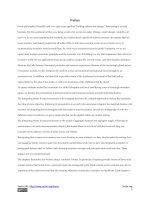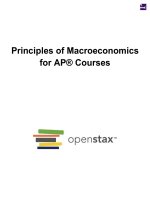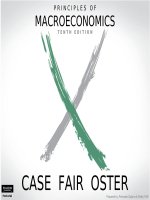Principles of macroeconomics 10e by case fair oster ch19
Bạn đang xem bản rút gọn của tài liệu. Xem và tải ngay bản đầy đủ của tài liệu tại đây (989.78 KB, 51 trang )
PRINCIPLES OF
MACROECONOMICS
PART V The World Economy
TENTH
EDITION
CASE FAIR OSTER
© 2012 Pearson Education, Inc. Publishing as Prentice Hall
Prepared by: Fernando Quijano & Shelly
1 ofTefft
31
PART V The World Economy
© 2012 Pearson Education, Inc. Publishing as Prentice Hall
2 of 51
PART V THE WORLD ECONOMY
International Trade,
Comparative
Advantage, and
Protectionism
19
CHAPTER OUTLINE
Trade Surpluses and Deficits
The Economic Basis for Trade: Comparative
Advantage
Absolute Advantage versus Comparative Advantage
Terms of Trade
Exchange Rates
The Sources of Comparative Advantage
The Heckscher-Ohlin Theorem
Other Explanations for Observed Trade Flows
PART V The World Economy
Trade Barriers: Tariffs, Export Subsidies, and
Quotas
© 2012 Pearson Education, Inc. Publishing as Prentice Hall
U.S. Trade Policies, GATT, and the WTO
Free Trade or Protection?
The Case for Free Trade
The Case for Protection
An Economic Consensus
3 of 51
The “internationalization” or “globalization” of the U.S. economy has occurred in
the private and public sectors, in input and output markets, and in firms and
households.
PART V The World Economy
The inextricable connection of the U.S. economy to the economies of the rest of
the world has had a profound impact on the discipline of economics and is the
basis of one of its most important insights:
All economies, regardless of their size,
depend to some extent on other economies
and are affected by events outside their borders.
© 2012 Pearson Education, Inc. Publishing as Prentice Hall
4 of 51
PART V The World Economy
Which economies are affected by other economies and by events
outside their borders?
a.
Usually small economies.
b.
Usually the larger economies are the ones affected.
c.
All economies, regardless of their size.
d.
None of the above. Domestic economies are independent and
hardly ever affected by events outside their borders.
© 2012 Pearson Education, Inc. Publishing as Prentice Hall
5 of 51
PART V The World Economy
Which economies are affected by other economies and by events
outside their borders?
a.
Usually small economies.
b.
Usually the larger economies are the ones affected.
c.
All economies, regardless of their size.
d.
None of the above. Domestic economies are independent and
hardly ever affected by events outside their borders.
© 2012 Pearson Education, Inc. Publishing as Prentice Hall
6 of 51
Trade Surpluses and Deficits
trade surplus The situation when a country exports more than it imports.
PART V The World Economy
trade deficit The situation when a country imports more than it exports.
© 2012 Pearson Education, Inc. Publishing as Prentice Hall
7 of 51
PART V The World Economy
Trade Surpluses and Deficits
TABLE 19.1 U.S. Balance of Trade (Exports Minus Imports), 1929–2009
(Billions of Dollars)
Exports Minus Imports
Exports Minus Imports
1929
1989
−87.9
+0.4
1933
1990
−77.6
+0.1
1945
1991
−27.0
−0.8
1955
1992
−32.8
+0.5
1960
1993
−64.4
+4.2
1965
1994
−92.7
+5.6
1970
1995
−90.7
+4.0
1975
1996
−96.3
+16.0
1976
1997
−101.4
−1.6
1977
1998
−161.8
−23.1
1978
1999
−262.1
−25.4
1979
2000
−382.1
−22.5
1980
2001
−371.0
−13.1
1981
2002
−427.2
−12.5
1982
2003
−504.1
−20.0
1983
2004
−618.7
−51.7
1984
2005
−722.7
−102.7
1985
2006
−769.3
−115.2
1986
2007
−713.8
−132.5
1987
−145.0
2008
−707.8
1988
−110.1
2009
−392.4
© 2012 Pearson Education, Inc. Publishing as Prentice Hall
8 of 51
PART V The World Economy
The trade situation of the United States changed significantly in 1976,
when the country began to experience continuous:
a.
Trade deficits.
b.
Trade surpluses.
c.
Trade imbalances.
d.
Trade creation and trade diversion.
© 2012 Pearson Education, Inc. Publishing as Prentice Hall
9 of 51
PART V The World Economy
The trade situation of the United States changed significantly in 1976,
when the country began to experience continuous:
a.
Trade deficits.
b.
Trade surpluses.
c.
Trade imbalances.
d.
Trade creation and trade diversion.
© 2012 Pearson Education, Inc. Publishing as Prentice Hall
10 of 51
The Economic Basis for Trade: Comparative Advantage
PART V The World Economy
Corn Laws The tariffs, subsidies, and restrictions enacted by the
British Parliament in the early nineteenth century to discourage imports
and encourage exports of grain.
theory of comparative advantage Ricardo’s theory that specialization
and free trade will benefit all trading partners (real wages will rise), even
those that may be absolutely less efficient producers.
© 2012 Pearson Education, Inc. Publishing as Prentice Hall
11 of 51
PART V The World Economy
Ricardo’s theory of comparative advantage states that specialization
and free trade will benefit:
a.
Only partners in trade that have absolute advantages.
b.
All trading partners, even those that may be absolutely less
efficient producers.
c.
Partners in trade that have comparative advantages, but not
absolute advantages.
d.
Only partners in trade that were absolutely less efficient
producers before trade.
© 2012 Pearson Education, Inc. Publishing as Prentice Hall
12 of 51
PART V The World Economy
Ricardo’s theory of comparative advantage states that specialization
and free trade will benefit:
a.
Only partners in trade that have absolute advantages.
b.
All trading partners, even those that may be absolutely
less efficient producers.
c.
Partners in trade that have comparative advantages, but not
absolute advantages.
d.
Only partners in trade that were absolutely less efficient
producers before trade.
© 2012 Pearson Education, Inc. Publishing as Prentice Hall
13 of 51
The Economic Basis for Trade: Comparative Advantage
Absolute Advantage versus Comparative Advantage
absolute advantage The advantage in the production of a
good enjoyed by one country over another when it uses fewer
resources to produce that good than the other country does.
PART V The World Economy
comparative advantage The advantage in the production of
a good enjoyed by one country over another when that good
can be produced at lower cost in terms of other goods than it
could be in the other country.
© 2012 Pearson Education, Inc. Publishing as Prentice Hall
14 of 51
The Economic Basis for Trade: Comparative Advantage
Absolute Advantage versus Comparative Advantage
Gains from Mutual Absolute Advantage
TABLE 19.2 Yield per Acre of Wheat and Cotton
Wheat
Cotton
New Zealand
6 bushels
2 bales
Australia
2 bushels
6 bales
PART V The World Economy
TABLE 19.3 Total Production of Wheat and Cotton Assuming No Trade, Mutual
Absolute Advantage, and 100 Available Acres
Wheat
Cotton
New Zealand
25 acres × 6 bushels/acre =
150 bushels
Australia
75 acres × 2 bushels/acre =
150 bushels
75 acres × 2 bales/acre =
150 bales
25 acres × 6 bales/acre =
150 bales
© 2012 Pearson Education, Inc. Publishing as Prentice Hall
15 of 51
The Economic Basis for Trade: Comparative Advantage
Absolute Advantage versus Comparative Advantage
PART V The World Economy
Gains from Mutual Absolute Advantage
FIGURE 19.1 Production Possibility Frontiers for Australia and New Zealand Before Trade
Without trade, countries are constrained by their own resources and productivity.
© 2012 Pearson Education, Inc. Publishing as Prentice Hall
16 of 51
PART V The World Economy
In order for two countries to gain from specialization and trade,
a.
The opportunity costs of producing the goods to be traded must be
different between the countries.
b.
Each country must specialize in the production of the good for
which it has a lower opportunity cost.
c.
Each country must specialize in producing the good for which it
has a comparative advantage.
d.
All of the above.
© 2012 Pearson Education, Inc. Publishing as Prentice Hall
17 of 51
PART V The World Economy
In order for two countries to gain from specialization and trade,
a.
The opportunity costs of producing the goods to be traded must be
different between the countries.
b.
Each country must specialize in the production of the good for
which it has a lower opportunity cost.
c.
Each country must specialize in producing the good for which it
has a comparative advantage.
d. All of the above.
© 2012 Pearson Education, Inc. Publishing as Prentice Hall
18 of 51
The Economic Basis for Trade: Comparative Advantage
Absolute Advantage versus Comparative Advantage
Gains from Mutual Absolute Advantage
TABLE 19.4 Production and Consumption of Wheat and Cotton after Specialization
Production
Wheat
New Zealand
Australia
100 acres ×
6 bushels/acre
600 bushels
0 acres
0 acres
0
100 acres × 6
bales/acre
600 bales
New Zealand
Australia
Wheat
300 bushels
300
bushels
Cotton
300 bales
300 bales
0
PART V The World Economy
Cotton
Consumption
© 2012 Pearson Education, Inc. Publishing as Prentice Hall
19 of 51
The Economic Basis for Trade: Comparative Advantage
Absolute Advantage versus Comparative Advantage
PART V The World Economy
Gains from Mutual Absolute Advantage
FIGURE 19.2 Expanded Possibilities After Trade
Trade enables both countries to move beyond their own resource
constraints—beyond their individual production possibility frontiers.
© 2012 Pearson Education, Inc. Publishing as Prentice Hall
20 of 51
The Economic Basis for Trade: Comparative Advantage
Absolute Advantage versus Comparative Advantage
Gains from Comparative Advantage
TABLE 19.5 Yield per Acre of Wheat and Cotton
New Zealand
6 bushels
6 bales
Wheat
Cotton
Australia
1 bushel
3 bales
PART V The World Economy
TABLE 19.6 Total Production of Wheat and Cotton Assuming No Trade and
100 Available Acres
New Zealand
Australia
Wheat
50 acres × 6 bushels/acre
300 bushels
75 acres × 1 bushels/acre
75 bushels
Cotton
50 acres × 6 bales/acre
300 bales
25 acres × 3 bales/acre
75 bales
© 2012 Pearson Education, Inc. Publishing as Prentice Hall
21 of 51
The Economic Basis for Trade: Comparative Advantage
Absolute Advantage versus Comparative Advantage
Gains from Comparative Advantage
TABLE 19.7 Realizing a Gain from Trade When One Country Has a Double Absolute
Advantage
Wheat
Cotton
STAGE 1
New Zealand
Australia
50 acres ×
0 acres
6 bushels/acre
300 bushels
0
50 acres ×
6 bales/acre
300 bales
100 acres ×
3 bales/acre
300 bales
Wheat
Cotton
STAGE 2
New Zealand
Australia
75 acres ×
0 acres
6 bushels/acre
450 bushels
0
25 acres ×
6 bales/acre
150 bales
100 acres ×
3 bales/acre
300 bales
PART V The World Economy
STAGE 3
Wheat
Cotton
New Zealand
Australia
100 bushels (trade)
350 bushels
100 bushels
(after trade)
200 bales (trade)
350 bales
100 bales
(after trade)
© 2012 Pearson Education, Inc. Publishing as Prentice Hall
22 of 51
The Economic Basis for Trade: Comparative Advantage
Absolute Advantage versus Comparative Advantage
Why Does Ricardo’s Plan Work?
PART V The World Economy
FIGURE 19.3 Comparative Advantage Means Lower Opportunity Cost
The real cost of cotton is the wheat sacrificed to obtain it. The cost of 3 bales of cotton in New Zealand is 3 bushels of wheat
(a half acre of land must be transferred from wheat to cotton— refer to Table 19.5).
However, the cost of 3 bales of cotton in Australia is only 1 bushel of wheat. Australia has a comparative advantage over New
Zealand in cotton production, and New Zealand has a comparative advantage over Australia in wheat production.
© 2012 Pearson Education, Inc. Publishing as Prentice Hall
23 of 51
The Economic Basis for Trade: Comparative Advantage
Terms of Trade
terms of trade The ratio at which a country can
trade domestic products for imported products.
Exchange Rates
PART V The World Economy
exchange rate The ratio at which two currencies are
traded. The price of one currency in terms of another.
© 2012 Pearson Education, Inc. Publishing as Prentice Hall
24 of 51
The Economic Basis for Trade: Comparative Advantage
Exchange Rates
Trade and Exchange Rates in a Two-Country/Two-Good World
TABLE 19.8 Domestic Prices of Timber (per Foot) and Rolled Steel
(per Meter) in the United States and Brazil
United States
Brazil
Timber
$1
3 Reals
Rolled steel
$2
4 Reals
TABLE 19.9 Trade Flows Determined by Exchange Rates
PART V The World Economy
Exchange Rate
Price of Real
Result
$1 = 1 R
$1.00
$1 = 2 R
.50
Brazil imports timber.
$1 = 2.1 R
.48
Brazil imports timber; United States imports steel.
$1 = 2.9 R
.34
Brazil imports timber; United States imports steel.
$1 = 3 R
.33
United States imports steel.
$1 = 4 R
.25
United States imports timber and steel.
© 2012 Pearson Education, Inc. Publishing as Prentice Hall
Brazil imports timber and steel.
25 of 51









